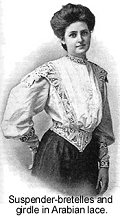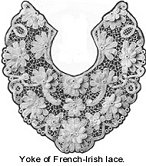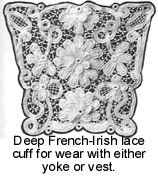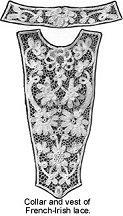

Click on thumbnails to enlarge.

The present great popularity of suspender and bretelle trimming suggests the feasibility of making the model shown. This illustrates bretelles made of heavy ecru Arabian braid, while a decided novelty is shown is a lace girdle made of the same ornamental braid. Trimming such as the above will be found very effective for a dressy winter house gown, in which case it would be advisable to place the girdle over a stiff-boned foundation, tacking it securely to hold it well in place. When the girdle is made unlined, it must be equipped with whalebone at back, front and sides, the pattern being designed with the lines of braid in order to afford these covering and support.
Unlined, this piece of lace is perhaps more useful, as it then more readily adapts itself to all dresses. But if one wishes to enhance it's effect, and is willing to curtail it's general usefulness, then line both shoulder straps and belt with silk, and arrange a tiny strip of plaiting of the same to edge the bretelles.
All those who have used the Arabian braids know that care and attention must be exercised in drawing and basting them, for the heavy cord which runs on the edge or center must be always flat and without kinks.

The girdle consists of four sections, which are joined together under the arms and at the front or back, according to one's wish to fasten the belt in either place. Being made in these four parts arranges for necessary spring above and below the waistline, and also allows one to fit the girdle to individual figures, by either taking in at side seams or enlarging by adding another straight row of braid. The bretelles are fastened back and front to the top of the girdle. The lace stitches need no description, the simplest ones of fagoting, spider wheels, and single mesh being used, which the substitution of a number of ring cuts out much needlework, and also gives boldness and strength to the design.
Ordinary white Battenburg braids may be used instead of the ecru Arabian in making the bretelles and girdle illustrated, and they would also be very effective if made of white Arabian braid or of black silk braid.
Real Irish crochet and braid laces in imitation of the crochet are being revived and finding much popularity. The remodeled form bears the rather anomalous name of "French-Irish", and aside from the fact that new braids are constantly appearing for it's construction, it varies little from the original Irish point. It's main feature is the very frequent use of double or raised [motifs], rows of petals being placed on above the other, causing the points to stand in relief, and producing a very sumptuous ornamentation; especially adapted to trimming winter fabrics, such as velvet, velveteen, or shaggy wools, as well as silk fabrics.
A vest front is shown and the design will be seen to closely resemble the [motifs] used in Irish crochet. This lace, it will be remembered, is made up of separate figures which are crocheted over heavy cord and then joined by means of irregular tracery of chain stitch dotted with tiny picots. Braids for this work are made with tiny draw-threads and heavy cords, which also draw, and it may be found easier to make many of the [motifs] off the pattern, as the heavy cords are more manageable when so handled. These separated [motifs] are then firmly basted on the pattern. Three lace stitches are employed in this vest-but only two need description, as fagoting is now as familiar as basting. The stitch used in the large rosette at the top of the vest consists of rows of twisted buttonhole stitch, placed one below the other. After one row is completed, the thread is twisted back along the loops just mad and the next row proceeds after the same manner.

A detail of the background stitch is shown. From this is will be seen that an irregular mesh is made by means of twisted buttonhole-stitches-a second thread is then twisted over al the loops so formed, and in the center of each picot stitch is taken, after which the thread is again wound round as before. The picot, may be made in several ways, absolute uniformity in size and shape not being essential. A simple method is, after twisting the thread until the location for the picot is reached, to make a knot-stitch which stays the winding of the thread. Put the needle in this knot and before passing it through wind the cotton five or six times round it, and the, holding the twisted part, pull through as in a French knot. After this proceed with the winding of the bar. The number of turns round the needle will of course regular the size of the picot. A course linen or crochet thread is used to form this background stitch, and as it may be placed with the utmost irregularity, it progresses rapidly. Where spaces are not large enough to permit [use] of the buttonhole webbing, ordinary twisted bars re used with the same small picot.
If one prefers, this background may be crocheted instead of stitched, the same result being obtained by crocheting an irregular mesh of chain stitches, with the picot loop in the center of each chain. This combination of needlework and crocheting is not thought incongruous, and oftentimes both crocheted and braid [motifs] are used in the same pattern.

A chemisette yoke is illustrated. It requires in making only the usual care in basting and drawing the braid. Irish braid may be cut often if one is regardless of the wrong side of one's lace, but if neatness and firmness are desired, refrain from cutting as far as possible. Remember it is quite possible to nip the draw-thread and heavy cord without cutting the surrounding braid, thereby making easy the task of gathering the braid without experiencing the quite considerable inconvenience of disposing of raveling ends.
The main stitchery, as may be seen, is the background. A square mesh is used in places, which is easily made by constructing a cross-bar of threads from side to side and from top to bottom, winding back on each thread and securing it at each intersecting bar with a knot stitch.
Heavy French-Irish will be found to be one of the most striking and satisfactory laces for many purposes. There are numerous braids, but none more effective than the white mercerized one used in the above illustrations
Interested? In the January/February 2001 issue of Piecework magazine, there was an article on how to make Romanian Point Lace, which has a similar look to the lace pictured in this article. The back issue is available for sale on Piecework's website.
A book that shows many similar stitches is Reader's Digest's The Complete Guide to Needlework. Plenty of illustrations showing various needle lace stitches.
Note: This article, by a Grace Aline Luther, was taken from a 1905 issue of The Designer. The techniques describe here have not been tried, and therefore Across the Ages cannot vouch for their work-ability.
Please contact the webmaster if you are experiencing any technical difficulties with this site.
About
Additions
Articles
FAQ
Feature
Links
Poll
Reviews
Resources
Sewing
©2003 Across the Ages